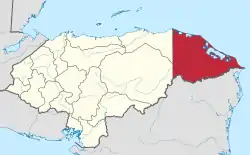Gracias a Dios Department
Departamento de Gracias a Dios | |
|---|---|
 Location of Gracias a Dios in Honduras | |
| Coordinates: 15°16′N 83°46′W / 15.267°N 83.767°W | |
| Country | |
| Municipalities | 6 |
| Villages | 69 |
| Founded | 21 February 1957 |
| Capital city | Puerto Lempira |
| Government | |
| • Type | Departmental |
| • Governor | Alberto Samuel Haylock (2014-2022) (PNH) |
| Area | |
| • Total | 15,876 km2 (6,130 sq mi) |
| Population (2015) | |
| • Total | 94,450 |
| • Density | 5.9/km2 (15/sq mi) |
| Time zone | UTC-6 (CDT) |
| Postal code | 33101 |
| ISO 3166 code | HN-GD |
| HDI (2017) | 0.526[1] low · 17th |
| Statistics derived from Consult INE online database: Population and Housing Census 2013[2] | |
Gracias a Dios (Spanish pronunciation: [ˈɡɾasjas a ˈðjos]; "Thanks to God" or "Thank God") is one of the 18 departments (departamentos) into which Honduras is divided. The departmental capital is Puerto Lempira; until 1975 it was Brus Laguna.
History
Once a part of the Mosquito Coast, it was formed in 1957 from all of Mosquitia territory and parts of Colón and Olancho departments, with the boundary running along 85° W from Cape Camarón south. The department is rather remote and inaccessible by land, although local airlines fly to the main cities.
Geography
Gracias a Dios department covers a total surface area of 16,997 km² and, in 2015, had an estimated population of 94,450.
Although it is the second largest department in the country, it is sparsely populated, and contains extensive pine savannas, swamps, and rainforests. However, the expansion of the agricultural frontier is a perennial threat to the natural bounty of the department.
The department contains the Caratasca Lagoon, the largest lagoon in Honduras.
Demographics
At the time of the 2013 Honduras census, Gracias a Dios Department had a population of 90,795. Of these, 81.15% were Indigenous (79.70% Miskito, 0.95% Mayangna), 16.30% Mestizo, 1.58% Black or Afro-Honduran, 0.82% White and 0.15% others.[3]
Crime
Gracias a Dios is known to be a place of relatively high crime. Due to its remoteness and the Honduran government having a relatively low ability to fight crime, trafficking of narcotics is common in Gracias a Dios. Criminal organizations are also common in the area.[4]
Municipalities
References
- ↑ "Sub-national HDI - Area Database - Global Data Lab". hdi.globaldatalab.org. Retrieved 2018-09-13.
- ↑ "Consulta Base de datos INE en línea: Censo de Población y Vivienda 2013" [Consult INE online database: Population and Housing Census 2013]. Instituto Nacional de Estadística (INE) (in Spanish). El Instituto Nacional de Estadística (INE). 1 August 2018. Retrieved 2018-09-13.
- ↑ Instituto Nacional de Estadística (INE), bases de datos en línea
- ↑ U.S. Department of State (2016-08-04). Honduras Travel Warning. 4 August 2016. Retrieved on 2016-09-15 from https://travel.state.gov/content/passports/en/alertswarnings/honduras-travel-warning.html Archived 2017-11-24 at the Wayback Machine.
External links